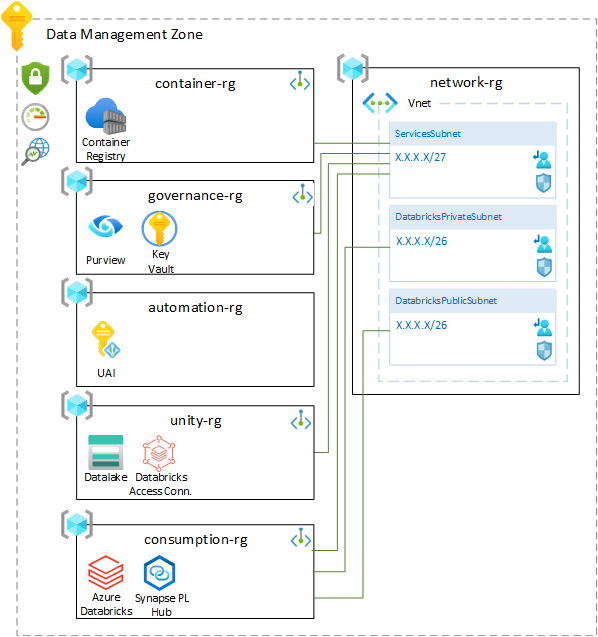This project revisits the Cloud Scale Analytics data platform reference architecture for Microsoft Azure. While the core principles of the architecture design have not changed, the next generation of the design will and enhance and introduce many new capabilities that will simplify the overall management, onboarding and significantly reduce the time to market.
Over the last couple of years, numerous data platforms have been built on the basis of Cloud Scale Analytics which resulted in a ton of learnings and insights. In addition to that, new services and features have been introduced, reached a GA status and common requirements have drifted. All these data points have been used to build this next iteration of the reference architecture for scalable data platforms on Azure.
The Cloud Scale Analytics reference architecture consists of the following core building blocks:
-
The Data Management Zone is the core data governance entity of on organization. In this Azure subscription, an organization places all data management solution including their data catalog, the data lineage solution, the master data management tool and other data governance capabilities. Placing these tools inside a single subscription ensures a resusable data management framework that can be applied to all Data Landing Zones and other data sources across an organization.
-
The Data Landing Zone is used for data retention and processing. A Data Landing Zone maps to a single Azure Subscription, but organizations are encouraged to have multiple of these for scaling purposes. Within a Data Landing Zone an orgnaization may implement one or multiple data applications.
-
A Data Application environment is a bounded context within a Data Landing Zone. A Data Application is concerned with consuming, processing and producing data as an output. These outputs should no longer be treated as byproducts but rather be managed as a full product that has a defined service-level-agreement.
The following architecture will be deployed by this module, whereby the module expects that the Vnet, Route Table and NSG already exists within the Azure Landing Zone and respective resource IDs are provided as input:
- An Azure subscription. If you don't have an Azure subscription, create your Azure free account today.
- (1) Contributor and User Access Administrator or (2) Owner access to the subscription to be able to create resources and role assignments.
- Databricks Account Administrator role in the Databricks Account.
- A GitHub self-hosted runner or an Azure DevOps self-hosted agent to be able to access the data-plane of services.
We recommend starting with the following configuration in your root module to learn what resources are created by the module and how it works.
# Configure Terraform to set the required AzureRM provider version and features{} block.
terraform {
required_providers {
azurerm = {
source = "hashicorp/azurerm"
version = "3.57.0"
}
azapi = {
source = "azure/azapi"
version = "1.6.0"
}
databricks = {
source = "databricks/databricks"
version = "1.17.0"
}
}
}
provider "azurerm" {
features {}
}
provider "azapi" {}
# Declare locals for the module
locals {
company_name = "<my-company-name>"
location = "northeurope"
location_purview = "northeurope"
prefix = "<my-prefix>"
vnet_id = "/subscriptions/<my-subscription-id>/resourceGroups/<my-rg-name>/providers/Microsoft.Network/virtualNetworks/<my-vnet-name>"
nsg_id = "/subscriptions/<my-subscription-id>/resourceGroups/<my-rg-name>/providers/Microsoft.Network/networkSecurityGroups/<my-nsg-name>"
route_table_id = "/subscriptions/<my-subscription-id>/resourceGroups/<my-rg-name>/providers/Microsoft.Network/routeTables/<my-rt-name>"
# If DNS A-records are deployed via Policy then you can also set these to an empty string (e.g. "") or remove them entirely
private_dns_zone_id_namespace = "/subscriptions/<my-subscription-id>/resourceGroups/<my-rg-name>/providers/Microsoft.Network/privateDnsZones/privatelink.servicebus.windows.net"
private_dns_zone_id_purview_account = "/subscriptions/<my-subscription-id>/resourceGroups/<my-rg-name>/providers/Microsoft.Network/privateDnsZones/privatelink.purview.azure.com"
private_dns_zone_id_purview_portal = "/subscriptions/<my-subscription-id>/resourceGroups/<my-rg-name>/providers/Microsoft.Network/privateDnsZones/privatelink.purviewstudio.azure.com"
private_dns_zone_id_blob = "/subscriptions/<my-subscription-id>/resourceGroups/<my-rg-name>/providers/Microsoft.Network/privateDnsZones/privatelink.blob.core.windows.net"
private_dns_zone_id_dfs = "/subscriptions/<my-subscription-id>/resourceGroups/<my-rg-name>/providers/Microsoft.Network/privateDnsZones/privatelink.dfs.core.windows.net"
private_dns_zone_id_queue = "/subscriptions/<my-subscription-id>/resourceGroups/<my-rg-name>/providers/Microsoft.Network/privateDnsZones/privatelink.queue.core.windows.net"
private_dns_zone_id_container_registry = "/subscriptions/<my-subscription-id>/resourceGroups/<my-rg-name>/providers/Microsoft.Network/privateDnsZones/privatelink.azurecr.io"
private_dns_zone_id_synapse_portal = "/subscriptions/<my-subscription-id>/resourceGroups/<my-rg-name>/providers/Microsoft.Network/privateDnsZones/privatelink.azuresynapse.net"
private_dns_zone_id_key_vault = "/subscriptions/<my-subscription-id>/resourceGroups/<my-rg-name>/providers/Microsoft.Network/privateDnsZones/privatelink.vaultcore.azure.net"
private_dns_zone_id_databricks = "/subscriptions/<my-subscription-id>/resourceGroups/<my-rg-name>/providers/Microsoft.Network/privateDnsZones/privatelink.azuredatabricks.net"
}
# Declare the Data Management Zone Terraform module and provide a base configuration.
module "data_management_zone" {
source = "PerfectThymeTech/data-management-zone/azurerm"
version = "0.1.1"
providers = {
azurerm = azurerm
azapi = azapi
}
company_name = local.company_name
location = local.location
location_purview = local.location_purview
prefix = local.prefix
vnet_id = local.vnet_id
nsg_id = local.nsg_id
route_table_id = local.route_table_id
private_dns_zone_id_namespace = local.private_dns_zone_id_namespace
private_dns_zone_id_purview_account = local.private_dns_zone_id_purview_account
private_dns_zone_id_purview_portal = local.private_dns_zone_id_purview_portal
private_dns_zone_id_blob = local.private_dns_zone_id_blob
private_dns_zone_id_dfs = local.private_dns_zone_id_dfs
private_dns_zone_id_queue = local.private_dns_zone_id_queue
private_dns_zone_id_container_registry = local.private_dns_zone_id_container_registry
private_dns_zone_id_synapse_portal = local.private_dns_zone_id_synapse_portal
private_dns_zone_id_key_vault = local.private_dns_zone_id_key_vault
private_dns_zone_id_databricks = local.private_dns_zone_id_databricks
}The following requirements are needed by this module:
-
terraform (>=0.13)
-
azapi (>= 1.5.0)
-
azurerm (>= 3.56.0)
-
databricks (>= 1.16.0)
No modules.
The following input variables are required:
Description: Specifies the name of the company.
Type: string
Description: Specifies the location for all Azure resources.
Type: string
Description: Specifies the location for Microsoft Purview. The location of Purview is bound to the Microsoft Entra ID location.
Type: string
Description: Specifies the resource ID of the default network security group for the Data Management Zone
Type: string
Description: Specifies the prefix for all resources created in this deployment.
Type: string
Description: Specifies the resource ID of the default route table for the Data Management Zone
Type: string
Description: Specifies the resource ID of the Vnet used for the Data Management Zone
Type: string
The following input variables are optional (have default values):
Description: Specifies the list of subscription IDs of your data platform.
Type: list(string)
Default: []
Description: Specifies the environment of the deployment.
Type: string
Default: "dev"
Description: Specifies the resource ID of the private DNS zone for Azure Storage blob endpoints. Not required if DNS A-records get created via Azure Policy.
Type: string
Default: ""
Description: Specifies the resource ID of the private DNS zone for Azure Container Registry. Not required if DNS A-records get created via Azure Policy.
Type: string
Default: ""
Description: Specifies the resource ID of the private DNS zone for Azure Databricks UI endpoints. Not required if DNS A-records get created via Azure Policy.
Type: string
Default: ""
Description: Specifies the resource ID of the private DNS zone for Azure Storage dfs endpoints. Not required if DNS A-records get created via Azure Policy.
Type: string
Default: ""
Description: Specifies the resource ID of the private DNS zone for Azure Key Vault. Not required if DNS A-records get created via Azure Policy.
Type: string
Default: ""
Description: Specifies the resource ID of the private DNS zone for the EventHub namespace. Not required if DNS A-records get created via Azure Policy.
Type: string
Default: ""
Description: Specifies the resource ID of the private DNS zone for the Purview account. Not required if DNS A-records get created via Azure Policy.
Type: string
Default: ""
Description: Specifies the resource ID of the private DNS zone for the Purview portal. Not required if DNS A-records get created via Azure Policy.
Type: string
Default: ""
Description: Specifies the resource ID of the private DNS zone for Azure Storage queue endpoints. Not required if DNS A-records get created via Azure Policy.
Type: string
Default: ""
Description: Specifies the resource ID of the private DNS zone for Synapse PL Hub. Not required if DNS A-records get created via Azure Policy.
Type: string
Default: ""
Description: Specifies the list of user object IDs that are assigned as collection admin to the root collection in Purview.
Type: list(string)
Default: []
Description: Specifies the cidr ranges of the subnets used for the Data Management Zone. If not specified, the module will automatically define the right subnet cidr ranges. For this to work, the provided vnet must have no subnets.
Type:
object(
{
private_endpoint_subnet = optional(string, "")
databricks_private_subnet = optional(string, "")
databricks_public_subnet = optional(string, "")
}
)Default: {}
Description: Specifies the tags that you want to apply to all resources.
Type: map(string)
Default: {}
The following outputs are exported:
Description: Specifies the id of the container registry.
Description: Specifies the id of the databricks access connector.
Description: Specifies the id of the datalake used as a default for the databricks metastore.
Description: Specifies the id of the databricks metastore.
Description: Specifies the id of the databricks workspace.
Description: Specifies the id of the Azure key vault provisioned for Microsoft Purview.
Description: Specifies the id of the Microsoft Purview account.
Description: Specifies the id of the Azure synapse private link hub.
This project accepts public contributions. Please use issues, pull requests and the discussins feature in case you have any questions or want to enhance this module.

